
How To Get Your Protein If You’re A Picky Vegetarian
Beyond beans
I never imagined that I’d be the kind of person who would find herself jumping up and down with unbridled excitement as the FedEx guy walks towards me with my first Vitamix in-tow. Alas, after a few years of half-assing a vegetarian lifestyle, with bouts of anemia, extreme fatigue, and various recurring ailments, it was time to make a change and start caring about my well-being as much as I care about the well-being of animals (the reason why I decided to cut out meat in my life in the first place).
Despite the stack of articles I’ve dogeared and links I’ve compiled with tips for how to get your protein and be a proper vegetarian, I've never used them. I never made those bean brownies or quinoa pastas or tofu casseroles. Because the problem is, I’m not just a vegetarian, I’m a picky vegetarian who hates all of the foods that vegetarians are supposed to love. That’s left me bruised and pale, suffering from skin irritations, moodiness, sleeplessness, headaches and a pretty poor chance of sustaining this meat-less lifestyle for much longer.
So, as a part of my New Years resolution to put more effort into treating my body right, I got a Vitamix and reached out to Nikki Ostrower, a nutritionist and founder of NAO Nutrition, and confessed my sins: 90 percent of my diet consists of bread and cheese, and I hate beans. I had to put it all out there in the open. I told her everything I was sure she didn’t want to hear. To my surprise, she wasn’t that surprised. As it turns out, lots of recently turned vegetarians have a rough time getting adjusted to a balanced diet. It takes us a while to figure out that we can’t just cut out meat, we have to replace it with other proteins. But the fact that I got a Vitamix and reached out for help is apparently the first of a few important and necessary life-changing steps. Because without a solid and consistent source of protein, our bodies are basically running on fumes, Ostrower explained.
“Protein is key to burning fat, firing up your metabolism, building lean muscles as well as aiding in the health of your adrenals and thyroid, as well as cell regeneration and repair. That's a tall order! Therefore, if you're a vegetarian, understanding the sources to get your protein from are essential to your overall health.”
And when we’re suffering from a protein deficiency, the signs are not always super obvious, because they exist on such a vast plane; symptoms vary and range from mood swings to joint and muscle pain to concentration issues and slow bowels. Many of these conditions are common enough that those who suffer from them often don't read too much into them, assuming they'll resolve on their own and not recognizing them for the problems they are. Even for those people who know they're protein deficient, it can still be hard to find ways to incorporate enough of it into their diet—particularly if they're picky eaters. For me, beans and legumes, traditionally a reliable protein source for vegetarians, are just never going to be in my grocery cart; it's not going to happen. But, luckily, there's always alternatives; soy, for example, really holds its weight as a top meat substitute.
“You want to aim for clean sources of protein that are organic and non-GMO, especially soy. Soy can typically be the go-to protein source for vegan or vegetarians. [But be careful, because oftentimes] soy is heavily genetically engineered and can be hard on digestion if you don't look for quality sources. Organic and fermented soy is best, like tempeh, natto, and miso. The fermentation process stops the effect of phytic acid, which then creates seamless digestion. Fermentation also creates probiotics which is the good bacteria in the body for nutrient absorption and assimilation," Ostrower says.
While it’s good to know that soy is a solid and easy to access protein, not everyone is a fan of it, in which case, you’ll have to be a little bit more creative. Quinoa, dairy, spirulina, and eggs are considered complete proteins, meaning they have all the essential amino acids intact.
“Amino acids are the building blocks of a protein and amino acids are the building blocks of our neurotransmitters... the feel good chemicals in our brain,” Ostrower explains.
And while you should definitely be focusing on your proteins while you're figuring out your vegetarian diet, you’ve got to make sure that you’re putting some thought into your veggies as well. They should be organic, they should be local, and they should be fresh. If you live in the New York area, you can sign up with a community supported agriculture (CSA) collective like Local Roots NYC, which will ensure that you get your own share of fresh, hyper-local, high quality vegetables. Each week you can pick them up at your local market and go home with a baggy of vegetables that you know you can trust to be the key to the nutrition you need.
If you’re just getting started with a Vitamix or similar high-powered blender, here’s a simple variation of a recipe Ostrower recommends for a serious dose of protein (23g) perfect for post workout-revival or a solid breakfast. Feel free to play around with it and fine tune it. The most important thing is that you find a protein-rich smoothie that you like and that you’ll be sure to make every day.
Protein-Packed Smoothie
1 cup of your favorite nut milk
1/2 frozen banana
A handful of Goji Berries
1 Tbs spirulina
1 scoop of your favorite protein powder
1 tsp chia seeds
A handful of baby spinach
Blend, drink, and enjoy!